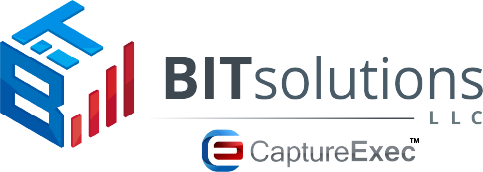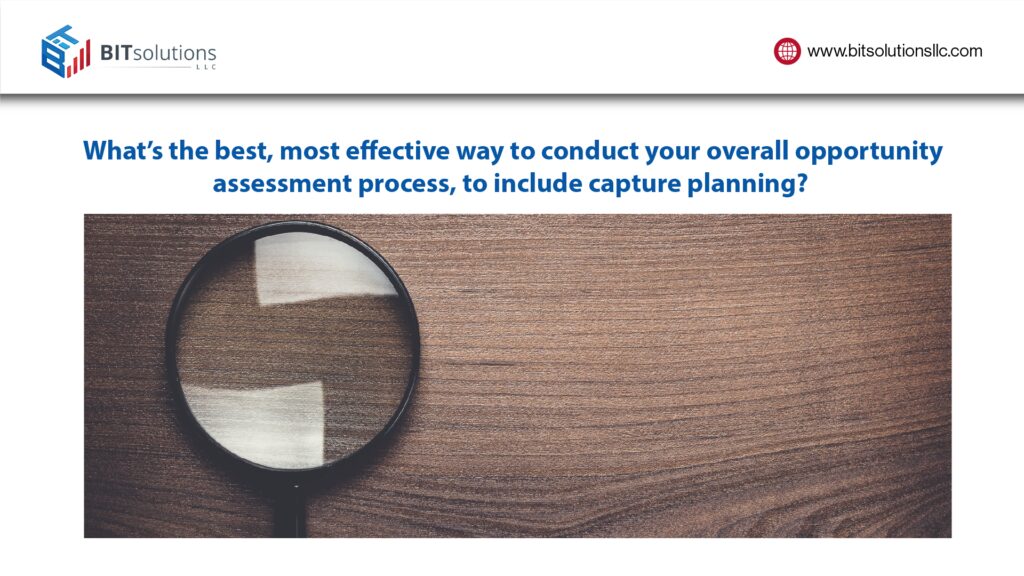What’s the best, most effective way to conduct your overall opportunity assessment process, to include capture planning?
At BIT Solutions Consulting, we advise our clients as follows:
At the very top level, there needs to be a strategic plan that’s ongoing and cyclical in nature. It should incorporate market analyses, budgets, marketing and technology plans, at a minimum. It’s a continuous exercise that ultimately dovetails with your business development team so they can start going after opportunities that make sense for your company.
Approximately 18-24 months before an opportunity drops, the first major phase of your opportunity process begins: Opportunity Identification. Here, market research and customer meetings take center stage and are critical to helping determine the viability of the opportunity; these activities will help you spot problems and issues that the customer needs help with and will be looking to be addressed in a proposal.
Your strategic plan should inform the opportunity identification process and establish those parameters by which you’ll sift through and narrow down viable opportunities to pursue. That said, it’s wise to go wider with your funnel and involve your capture managers to help do the sorting–this way, you don’t miss anything that could be viable, and you get those managers an early look at the potential opportunities that are on the horizon.
Once you’ve gathered all the opportunities, you conduct a Gate One review, which can be used at the lowest level to decide whether this opportunity is something you want to dig deeper into. As you narrow this list down, the process moves into the next phase, Opportunity Assessment.
Opportunity Assessment, occurring 12-18 months out from release, entails steps like attending industry days, gathering customer requirements and needs, and verifying alignment with your strategic plan and priorities. Your goal here is to eliminate anything that does not fit with your plan, since eventually, you’ll be putting real money, time, and other resources into actively pursuing the opportunity.
One tip for qualifying opportunities in this stage is to consult with previous RFPs in that space, do a statement of work analysis, and use the results of this analysis to assess your chances from a past performance and other award criteria perspective. You can also start assessing the incumbent competition and conducting more meetings with the customer to widen your perspective of their requirements, identify pain points, and other history relevant to the opportunity. Try to ascertain things like incumbent overall performance, employee turnover rate, position staffing timelines/delays, and whether the incumbent is liked or disliked.
In the Assessment phase, you’ll also begin formulating a solution and creating a price-to-win strategy to go along with that solution. This should include identifying a value proposition, and crafting a teaming and staffing strategy. Determine whether priming or subbing the opportunity makes more sense, given all of the known factors.
At the end of Assessment, hold a Gate Two review, where you’ll review the pursuit plan package and ask yourself whether you were able to gather enough information that indicates alignment with your strategy. This review acts as a “go/no-go” decision meeting, and should result in about 2/3rds of opportunities falling out of the pipeline. For those that make it through, you’ll assign a capture manager and identify a budget for the opportunity.
Finally, you enter the third phase: Capture Management, which typically occurs throughout the 3-12 months before the opportunity is released. Your capture manager should be doing things like executing a call plan, conducting an OCI analysis, refining the baseline solution, and updating the price-to-win as more information becomes apparent, among other activities.
You’ll finish up this third phase with a Gate Three review that includes verification that nothing new emerged in the draft RFP, for example, that suddenly disqualifies the opportunity. You’ll update your capture plan, develop an initial proposal plan, and assign a proposal manager to the pursuit.


